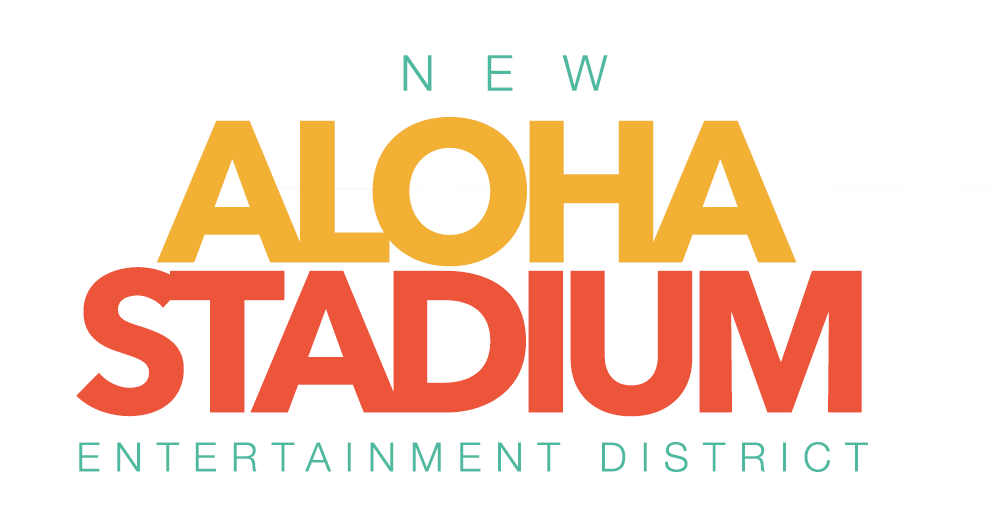Honolulu Star-Advertiser
Hawaii News
By Andrew Gomes
May 7, 2021
On Thursday the state agency managing Aloha Stadium voted to approve demolishing the existing stadium before a new facility opens.
Along with a new stadium, the Stadium Authority is looking at a major development that could include 3,300 homes, 650 hotel rooms, retail space approximating the size of Kahala Mall and offices for roughly 800 workers — all rising where cars and tailgaters used to gather for the biggest events at Aloha Stadium.
That’s what planning consultants working for the state believe is possible over 20-plus years as part of a plan to replace Hawaii’s largest, yet badly deteriorated, outdoor event venue with a smaller stadium surrounded by new residential and commercial uses.
This “possible picture” was presented at an online briefing Tuesday to bolster interest and feedback from real estate developers expected to compete to build a community around a new stadium in Halawa collectively referred to as the “New Aloha Stadium Entertainment District,” or NASED.
Stacey Jones, senior principal of Crawford Architects, said the scope he described for development around a new stadium is based on a market demand study, and that developers are encouraged but not required to provide such specific elements when submitting competitive proposals for state consideration.
“We expect the best ideas to come from you folks — not from us,” said Jones, whose firm, based in Australia and Kansas City, Mo., was hired by the state.
Jones said the market study showed that within five years after a new stadium opens, there should be demand for 850 homes, 200,000 square feet of retail, a 200-room hotel and 60,000 square feet of office space.
Over 20 years or so, this demand should grow to 3,300 homes, 400,000 square feet of retail, 650 hotel rooms and 120,000 square feet of office space, Jones told about 90 meeting attendees.
“It’s a heady opportunity,” he said. “Twenty years is not that long in real estate terms. … Rome wasn’t built in a day, and neither will NASED.”
Under the state’s plan, one of three already qualified private development teams would be paid to replace 50,000-seat Aloha Stadium with a new facility containing about 30,000 to 35,000 seats on 20 acres adjacent to the existing stadium. The winning team also would be paid to maintain the new stadium for 30 to 40 years for an arranged price.
The Stadium Authority, the state agency managing Aloha Stadium, would continue to manage and earn revenue from a new stadium under a procurement process that has been largely driven by the state Department of Accounting and General Services.
DAGS expects to seek proposals in July from the three contenders to build and maintain the new stadium after demolishing the 46-year-old existing stadium.
The Stadium Authority is OK with demolishing the old stadium first.
Previously, the state’s plan was to finish a new stadium before demolition so that events including University of Hawaii football games could continue. But because of COVID-19, the Stadium Authority let UH know in December that the stadium would not be available for use because no revenue was flowing in to maintain the facility now considered unsafe for fans.
The Stadium Authority said Thursday that demolishing Aloha Stadium first will cost less than its original plan and that savings will go toward redevelopment.
Lawmakers in 2019 appropriated up to $350 million in bonds and general funds for the project, though DAGS recently said its estimated stadium replacement cost has risen to $423 million.
Leasing the 78-acre balance of the stadium’s existing 98-acre site to a private developer to produce a new residential and commercial community is expected to generate revenue for the state to offset taxpayer costs for a new stadium.
Jones said the state’s vision is to have a mixed- use community that ideally would include workers and not only residents and people visiting the stadium site for entertainment and other things.
Oahu has had a weak office market in recent decades, but Jones said the market study indicates there is demand for new office space in the area and that it would enhance activity on the site with people arriving for work in the morning and leaving in the evening.
“What we’re anticipating is a mix of residential, retail/entertainment, hotels, hopefully, (and) some office because we’d also like this to be not just a live, play, thrive environment, but also work.”
Jones said the state would like to see the footprint of the existing stadium become a public gathering place, perhaps a tiered amphitheater with views of the stadium scoreboard that could be used for outdoor performances and other things.
The consultant envisioned that initial development around a new stadium would begin adjacent to a rail station in one corner of the property expected to serve commuters between Middle Street and East Kapolei around 2024 when it could be possible to have a new stadium open.
DAGS anticipates publishing a request in July for prospective developers to submit credentials to take on the project around a new stadium, followed by a request for proposals and then selecting and finalizing terms with a winning developer by mid-2022.
READ FULL ARTICLE HERE.

